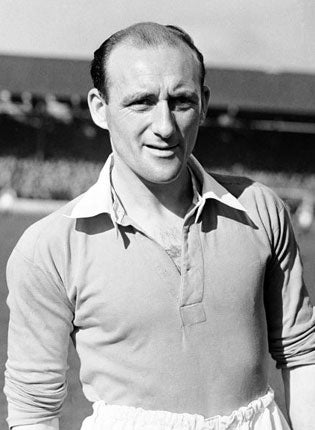Bert 'Sailor' Brown: Gifted footballer whose career was shattered by the Second World War

Your support helps us to tell the story
From reproductive rights to climate change to Big Tech, The Independent is on the ground when the story is developing. Whether it's investigating the financials of Elon Musk's pro-Trump PAC or producing our latest documentary, 'The A Word', which shines a light on the American women fighting for reproductive rights, we know how important it is to parse out the facts from the messaging.
At such a critical moment in US history, we need reporters on the ground. Your donation allows us to keep sending journalists to speak to both sides of the story.
The Independent is trusted by Americans across the entire political spectrum. And unlike many other quality news outlets, we choose not to lock Americans out of our reporting and analysis with paywalls. We believe quality journalism should be available to everyone, paid for by those who can afford it.
Your support makes all the difference.With his rolling gait and muscularly stocky build, he reminded his team-mates so irresistibly of the cartoon character Popeye that they nicknamed him “Sailor”. But Bert Brown was never a figure of fun; rather he was an enchantingly gifted inside-forward who might have scaled the giddiest heights of the game had his career impetus not been shattered by the outbreak of the Second World War.
Brown was 23 and already making an impressive impact with Charlton Athletic, then one of the leading clubs in the English top flight, when the global conflict began in 1939 and professional sport was properly relegated to the periphery of life for the next six years. As it was he served his country as an RAF sergeant, his footballing pinnacles being limited to half a dozen appearances for England alongside the likes of Stanley Matthews and Tommy Lawton in unofficial wartime internationals for which caps were not awarded, and representing the Addicks with intermittent brilliance in the 1946 FA Cup final.
It had been evident early in Brown’s life that he was blessed with exceptional talent. At the age of 10 he was excelling in a Yarmouth Boys team, consisting mostly of teenagers, and after shining for his local Eastern Counties League club, Gorleston, while working as an apprentice sewing machine mechanic, he signed for Charlton, then in the Third Division South, in August 1934.
By the time he made his senior debut in a 2-0 victory over Birmingham City at The Valley in January 1938, the south-east London side had risen to the premier tier and were among the title challengers. Brown was not overawed by the rise in standard, contributing 24 goals in 60 senior games before Hitler invaded Poland, but it was as a creator of goal-scoring chances for his colleagues that he earned the most lavish bouquets.
“Sailor” was a subtle and supremely deft manipulator of a football, adept at dispatching inch-perfect through-passes to fellow attackers such as George Tadman and Don Welsh, and soon he was on the verge of international recognition. When he did don the England shirt, though, it was in a non-ranking friendly in South Africa in 1939, and he was still in contention six years later when he scored in a 3-2 victory over Scotland. Throughout the war Brown remained an active footballer, captaining the RAF team, guesting for a host of clubs including Newcastle United, West Ham United, Millwall, York City, Leicester City, Manchester City, Wolves and East Fife, and continuing to serve Charlton.
He played in Wembley finals in four successive years – for Charlton in the League Cup South in 1943 and 1944, for Millwall in the same competition in 1945, and in Charlton’s 4-1 defeat by Derby County in the first post-war FA Cup final in 1946. Brown almost emerged as the Addicks’ hero of the latter contest when, deep in the second half and before a goal had been scored, he dribbled past five defenders only to give the ball away with an uncharacteristically inaccurate pass instead of sending in the skipper Don Welsh for what surely would have been the winner. The game went to extra time and a Derby team, which included the magnificent duo of Raich Carter and Peter Doherty, prevailed with plenty to spare.
Shortly afterwards Brown had a sharp difference of opinion with the Charlton manager Jimmy Seed and was transferred to Second Division Nottingham Forest for £6,750. In October 1947 he moved on again, returning to the top grade with Aston Villa, who paid £10,000 for his services, only to lose them for good when the 32-year-old suffered a severely broken jaw in an encounter with Portsmouth a year later.
Brown never featured at the top level again, but enjoyed serial success as player-manager of his old club, Gorleston, garnering several trophies and masterminding their progress to the first round proper of the FA Cup in 1951-52, when they bowed to Leyton Orient only after two replays. He retired from the game in 1956, then ran a sportswear shop, worked as a bookmaker and a timber merchant, and for a time scouted for Arsenal.
Brown, a chirpy, charming individual who became Charlton’s oldest surviving former player, lived for most of his life in Gorleston, later moving to Scotland to be near his daughter Julie.
Ivan Ponting
Robert Albert John Brown, footballer: born Norfolk 7 November 1915; played for Charlton Athletic 1934-46, Nottingham Forest 1946-47, Aston Villa 1947-49; married Daisy Aldridge (died 2001, one son, two daughters); died Forres, Morayshire 27 December 2008.
Join our commenting forum
Join thought-provoking conversations, follow other Independent readers and see their replies
Comments